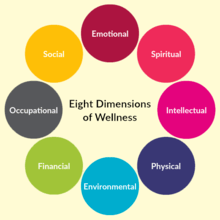Wellness (alternative medicine)

Wellness is generally used to mean a state beyond absence of illness but rather aims to optimize well-being.[1]
The notions behind the term share the same roots as the alternative medicine movement, in 19th-century movements in the US and Europe that sought to optimize health and to consider the whole person, like New Thought, Christian Science, and Lebensreform.[2][3]
The term was partly inspired by the preamble to the World Health Organization’s 1948 constitution which said: “Health is a state of complete physical, mental and social well-being and not merely the absence of disease or infirmity.”[1] It was initially brought to use in the US by Halbert L. Dunn, M.D. in the 1950s; Dunn was the chief of the National Office of Vital Statistics and discussed “high-level wellness,” which he defined as “an integrated method of functioning, which is oriented toward maximizing the potential of which the individual is capable.”[1] The term "wellness" was then adopted by John Travis who opened a "Wellness Resource Center" in Mill Valley, California in the mid-1970s, which was seen by mainstream culture as part of the hedonistic culture of Northern California at that time and typical of the Me generation.[1] Travis marketed the center as alternative medicine, opposed to what he said was the disease-oriented approach of medicine.[1] The concept was further popularized by Robert Rodale through Prevention magazine, Bill Hetler, a doctor at University of Wisconsin–Stevens Point, who set up an annual academic conference on wellness, and Tom Dickey, who established the Berkeley Wellness Letter in the 1980s.[1] The term had become accepted as standard usage in the 1990s.[1]
By the late 2000s the concept had become widely used in employee assistance programs in workplaces, and funding for development of such programs in small business was included in the Affordable Care Act.[2] The use of corporate wellness programs has been criticised as being discriminatory to people with disabilities.[4] At the same time, while there were magazines devoted to wellness, it was noted that mainstream news sources had begun to devote more page space to "health and wellness themes".[5]
The US Substance Abuse and Mental Health Services Administration uses the concept of wellness in its programs, defining it as having eight aspects: emotional, environmental, financial, intellectual, occupational, physical, social, and spiritual.[6]
The wellness trend has been criticised as a form of conspicuous consumption.[7]
See also
Reference
- 1 2 3 4 5 6 7 Zimmer, Ben (2010-04-16). "Wellness". The New York Times.
- 1 2 Kirkland, Anna (1 October 2014). "What Is Wellness Now?". Journal of Health Politics, Policy and Law. 39 (5): 957–970. doi:10.1215/03616878-2813647. ISSN 0361-6878.
- ↑ Blei, Daniela (4 January 2017). "The False Promises of Wellness Culture". JSTOR Daily.
- ↑ Basas, Carrie Griffin, What's Bad About Wellness? (August 1, 2014). Journal of Health Politics, Policy and Law, Vol. 39, No. 5, 2014. Available at SSRN: https://ssrn.com/abstract=2478902
- ↑ Kickbusch, Ilona; Payne, Lea (1 December 2003). "Twenty-first century health promotion: the public health revolution meets the wellness revolution". Health Promotion International. 18 (4): 275–278. doi:10.1093/heapro/dag418.
- ↑ "The Eight Dimensions of Wellness". Substance Abuse and Mental Health Services Administration (SAMHSA). 2016.
- ↑ Bearne, Suzanne (1 September 2018). "Wellness: just expensive hype, or worth the cost?". the Guardian. Retrieved 7 September 2018.